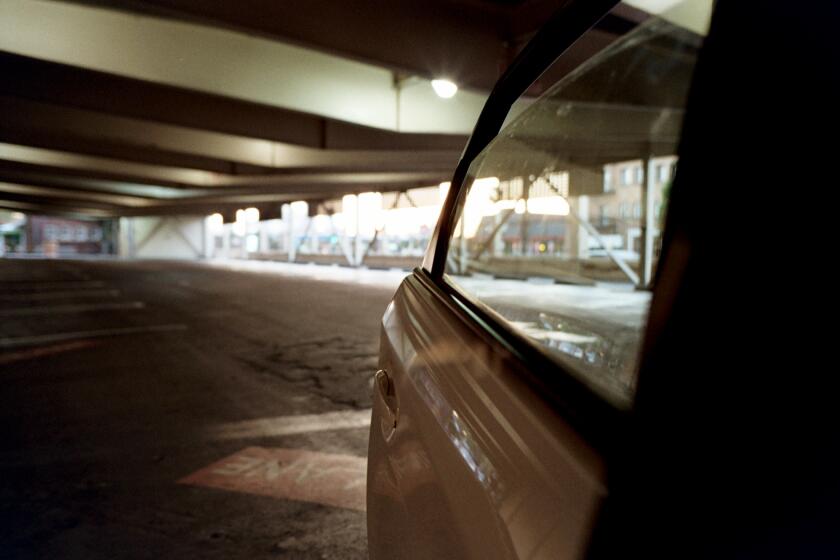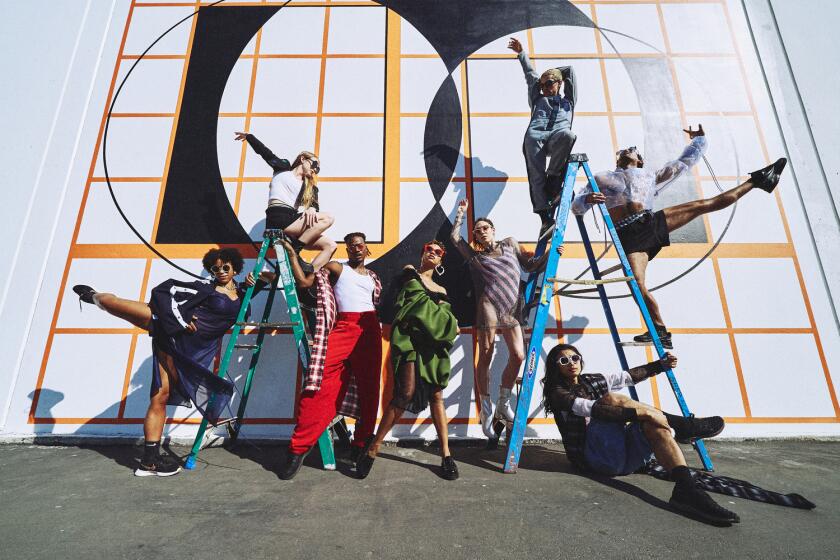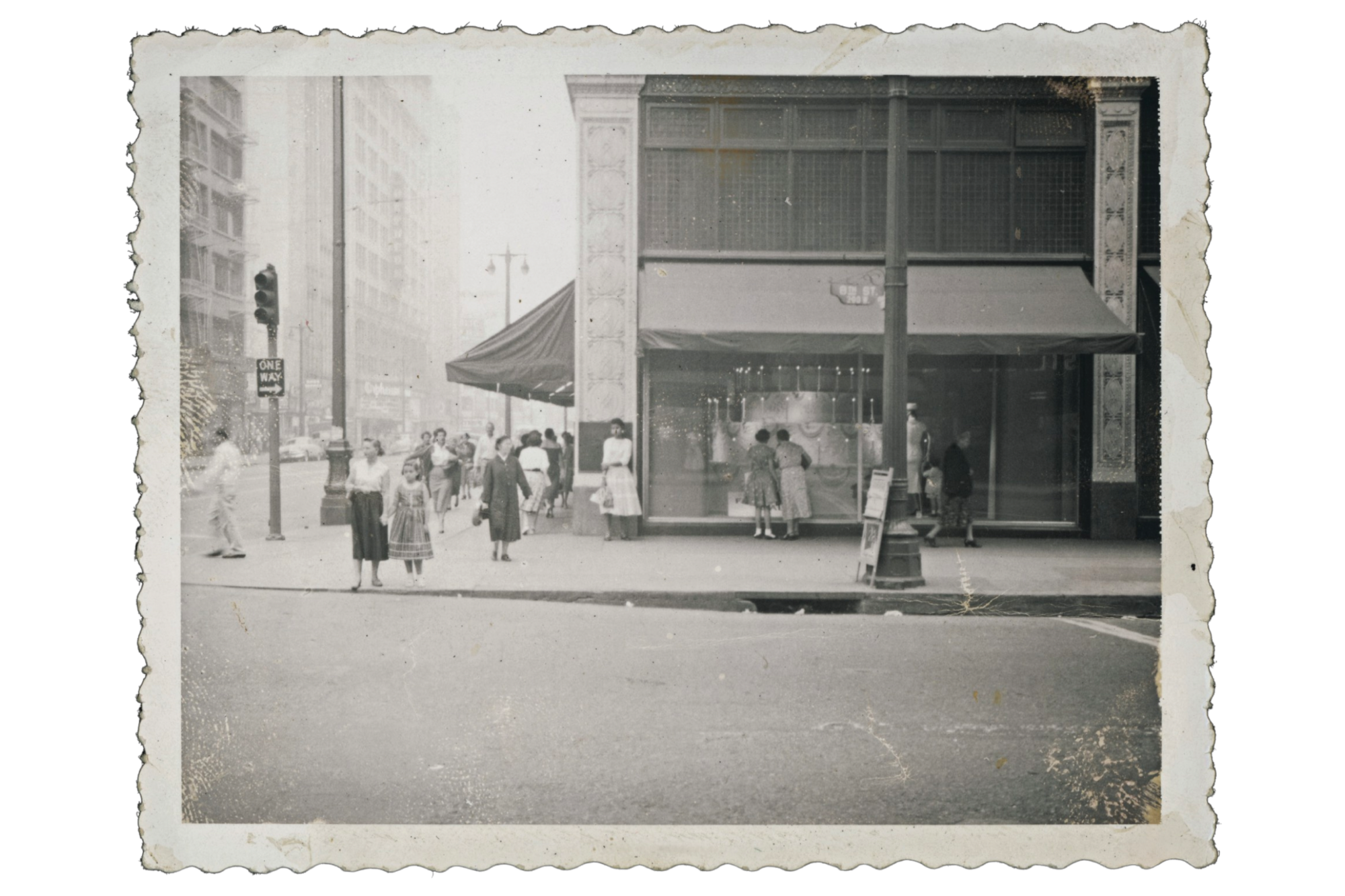
- Share via
This story is part of Image Issue 16, “Interiority,” a living archive of L.A. culture, style and fashion that shows how the city moves from the inside. Read the whole issue here.
“I am trying to make the dead/ clap and shout.”
So ends the first section of poet Robin Coste Lewis’ new book, “To the Realization of Perfect Helplessness.” The “dead” Lewis refers to aren’t simply her direct forebears, though the book is rife with archival photos of her relatives, but all of our ancestors as human beings, and particularly those of members of the African Diaspora. “To the Realization of Perfect Helplessness” is a hybrid text concerned with the recent past and excavating what Lewis calls deep time — millennia of Black art-making, community-building and innovation. To accomplish this excavation, Lewis arranges photos she discovered 25 years ago in a suitcase at her grandmother’s home so that they are in conversation with her own layered, lush poetry. The result is a book steeped in a particular history — Black migrants from Louisiana living in Los Angeles in the 20th century — yet buoyed by a feeling of boundlessness.
The cover photo is one that Lewis is near certain her grandmother, seamstress and amateur photographer Dorothy Mary Coste Thomas Brooks, took herself. Unlike the majority of the photos within the book, which are portraits, this one is of a busy intersection in downtown L.A., right in front of the old May Company building. It is the sort of photo that reveals something new every time you look at it.
Lewis’ debut poetry collection, “The Voyage of the Sable Venus,” won the 2015 National Book Award, and she was the poet laureate of the City of Los Angeles from 2017 to 2020. Born in Compton and raised in Carson, she holds a master‘s of theological studies degree in Sanskrit and comparative religious literature from Harvard Divinity School, an MFA in poetry from New York University and a PhD from USC’s Creative Writing and Literature Program. She is currently Writer-in-Residence at USC, which is where we met to have this conversation.
Angela Flournoy: “Use nostalgia, don’t be nostalgic.”
Robin Coste Lewis: Cecilia Dougherty, the really incredible filmmaker, when she first saw the archive and knew I was going to do a project, said to me, “Use nostalgia, don’t be nostalgic.” And I think that’s why it took so long for me to write this book. I have trashed like 20,000 pages of different projects, different ideas, different ways of entering it. It wasn’t until this year that I wrote the first third. And I wrote it because everybody was dying. I lost 23 friends under COVID — not just from COVID but other things. I wasn’t sure we were going to make it; I wasn’t sure I was going to make it. So, I was like, “Well, if that’s the case, is there anything you really want to finish?” And it was this book.
The first third is what I wrote under COVID. I wrote it for a project I was doing with Julie Mehretu, but then after I wrote it for her, I realized that it was actually for this book. It was the key. I did not want to write a “Roots” — not that there’s anything wrong with that book, it’s a canonical text, and I revere it. But it just would have been so easy to write about the characters and the photographs, and that wasn’t my project. My project was more about the frame that we have been locked in — Black people, I mean, but really, all human beings — the frame of history, the frame of time, all of these ideas that we tell ourselves, about ourselves, are too limited and too short.
More stories from Interiority
rafa esparza on the story of ‘Corpo RanfLA: Terra Cruiser’
Sam Muller unpacks the oral history of Hollywood High 16
Julissa James examines the style legacy of Homies
Angela Flournoy talks to Robin Coste Lewis about ‘deep time’
Alan Nakagawa remembers the Japanese market on wheels
For example, the whole idea of “four centuries” [of history] I find very insulting to apply towards Black people. The book is more of an investigation, a corrective of time. The text is about the evolution of human beings, the evolution of our planet, the history of the cell, the history of bacteria, because I really want it to relocate Black Americans in a vaster history because we belong there.
Partly the reason why I wrote this piece for Julie is I’m obsessed with this cave in South Africa called the Blombos Cave. They found a piece of artwork that’s 70,000 years old, that an early human had carved with a piece of stone. But we never hear about that piece. We hear about the caves of Lascaux. It’s always been that other cave art throughout Europe has been used to situate Europe as the kind of birthplace of fine art. It’s only now in the last decade or two that paleontologists have started finding art shards all over the world, and the oldest they found so far is in South Africa. Just imagine if we had grown up knowing that, how we would think about the art world?
That, for me, even as somebody who is an ancient language specialist, really shook me, and made me angry and sad but also ecstatic. Because we know that we’ve been around for a much longer time than four centuries and that our contributions have been going on for thousands and thousands of years. And so, I wanted to have these photographs stand in concert with that knowledge — my family, my ancestors, people in the diaspora, we have a history that is deep time too.
AF: That’s one thing that I was struck by reading this. There’s this interest in the deep time, and in some ways, it’s both an acknowledgement of our individual insignificance but also our lineage that is much longer and vaster than is usually acknowledged. And then, next to that, you have these small moments — you have a photo of a child in a yard. When I think about the value of archives, it’s exactly that kind of combination. How long did it take you before you realized the value of not just keeping these photos for your family archive but making something for everybody?
RCL: I never intended to keep them. I just intended to keep them safe. When I found them, I knew that I didn’t know what I was looking at, even though I knew a lot of people in these photographs. I just knew that I was too young to understand what I was inheriting.
You know that thing, as you start to hit your 30s, you start to realize, “Oh, I actually don’t know much about anything”? I think it just increases as you get older. Here I am, three graduate degrees later, and I definitely know nothing. Human beings are a mystery. I’m a mystery for myself. You’re a mystery to me, my dearest friends. And so, I’d look at these photographs of my family members who I grew up with — who took care of me growing up — and realize, as I got older, I knew nothing about them. The reason why I didn’t write anything about them is I felt completely uncomfortable pretending that they were capable of being known, and especially by me — I knew that was a false, romantic retrospection onto some photographs of people I once loved.
I knew that if I was going to put words with them, that they better be really good words that did not allow the viewer to settle into some nostalgic reverie. Because these photographs were taken during a reign of pure terror, and it’s really easy for readers to think, “Oh, that’s such a beautiful photograph.” And it is, right? That’s a beautiful woman in that photograph. But make no mistake — these people were living under an apartheid regime. And yet here they are, finding joy in these little snapshot moments.
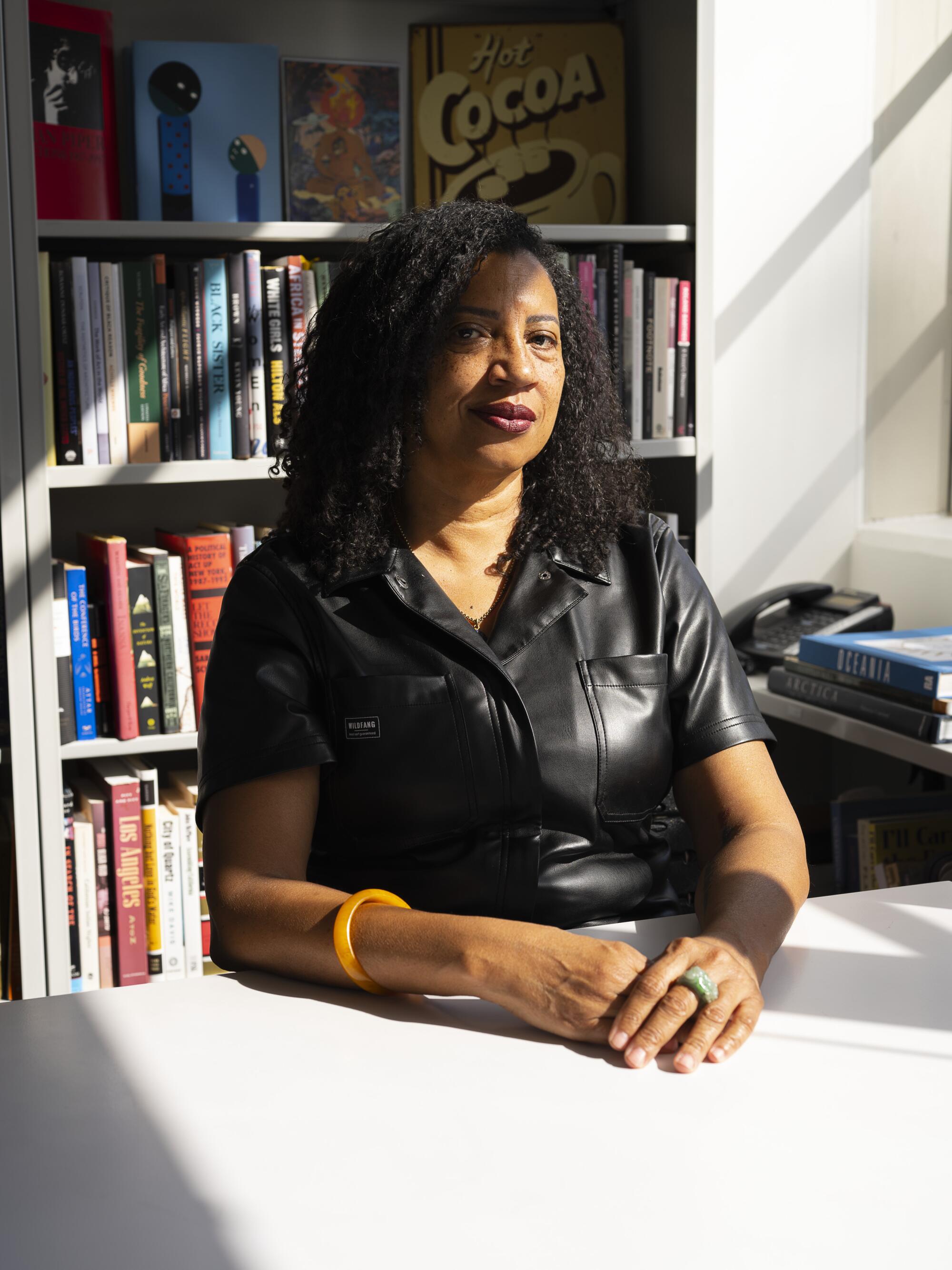
AF: You talked about how it felt like you weren’t quite ready to offer these people up, to presume that because you knew them at this one period of time, that you can write a succinct summary of who they were. That’s one of the things that really fascinates and confounds me about experiencing loss is the way that, from then on out, everyone who has never met that person, in your effort to describe them, they’re becoming an abstraction of some type. I was thinking about you and Julie working together, where you have these beautiful, monumental abstract works. And then you have these photos, which in some ways people would say are concrete — you can describe them. I’m interested to hear you talk more about photography and the relationship to abstraction, and poetry, which is also ripe for such beautiful abstraction.
RCL: That’s what I’m trying to play with — it looks like it’s a nostalgic photo album, but the text is incongruous with the images. I’m hoping it gives the reader an experience of abstraction, because they don’t meet up — not in terms of nonsense but in terms of existential mystery. That’s really hard to pull off with a medium like photography that is grounded in figuration. I hope the text takes that habit of perception and scrambles it.
Why do you think you get to know everything about everybody? And why do we think that we know anything about Black culture at all, after four centuries, and three of those centuries were spent in complete terror? And the last 100 years have been spent in mild terror? How can you get to know somebody if they are in a state of complete terror? I know who my grandmother was to me. I know the persona that she gave me. And I know what an exquisite experience it was to be loved by her. Who she was in the dark at night, who she was when she was afraid — I never saw my grandmother show any fear, ever, about anything. And that’s crazy. She was born in 1908 in Louisiana. Can you imagine all that she saw? What I know, for sure, is that I never knew her. That’s what I’m trying to get at — can I help to readjust this notion that we are so easily known.
AF: Thinking about this particular photo in downtown L.A. that you chose for the cover of your book, why are there so many Black people on the street?
RCL: Girl, I love this photo so much. This photo is actually 2 by 3 inches, and it’s taken on 8th and Broadway. This is the corner of a department store, May Company. Here I am doing 25 years of research, and what I can tell you is that my grandmother was sewing in downtown L.A. at this time; she was working in a sewing factory. So it’s almost for certain that she took this photograph because the dates line up. Also, my grandmother loved May Company. But also, do you see this cake in the window? We were wondering whether she was shooting the cake — and [if so], my grandmother had one of the most extraordinary photographic eyes. I think about Vivian Maier, for example. There are all these women walking around with cameras at this time, taking photographs on the streets, but no one’s taking them seriously. Look at the way this photograph rhymes — this guy is walking off-frame to the left, this woman’s walking off-frame to the right. It’s just perfectly choreographed. It’s like what you were saying earlier about these moments being captured in this deep time. For me, this photograph is a meditation on infinity.
AF: If you’re from here, like us, this is a context that people don’t associate with the city, especially in this time period. If you were to tell me this was on Central, I’d be like, oh, yeah.
RCL: Absolutely. And it’s downtown. Sidewalks are historically charged places for Black people and people of color all over the world. During colonialism, people of color were not allowed to walk on their own sidewalks in their own countries if they were colonized. I’ve been fascinated with sidewalks because the history of the sidewalk as a place of privilege is something that we forget about all the time. So, you’re absolutely right, the fact that these Black women are walking on the sidewalk — and at this time, Black people could walk on sidewalks but not too long before that they couldn’t — it’s also a site of occupation. They’re occupying the street, which I love.
AF: You mention, at the end, about the way that this book is also meditating on the idea of migration and the imagination and reinvention of that.
RCL: What I’m trying to say, and I hope I’m successful, is that the Great Migration is also an allegory for the migration of human beings. It’s the largest migration in human history in the United States — which people also tend to kind of hear and then don’t marvel, and that just pisses me off. It’s like, did you hear what I said? The largest migration of human beings in this country — and not only was it a migration but they were fleeing terror. Any time you say Black people are doing something, the bar drops to the floor, and I want the bar in the sky. Because what they survived, and what they knew, and how they survived, is extraordinary.
Now I should talk about Matthew Henson, because I’m obsessed with Matthew Henson, [and that’s where the title of the book comes from]. I’ve been writing about him for a long time; the long poem in the middle, called “The Ark,” is about him. Here you have this man who goes to the Arctic at 18 as a cabin boy for Commander Peary. They do five or six expeditions over 23 years and [Henson is] the person who’s putting the pole into the North Pole. Of course, Matthew Henson, a Black man, doesn’t get credit for discovering the North Pole. But more than that, reading his memoir — this is the Blackest story ever. You’re out there in all this white space. There are Indigenous communities everywhere, but people don’t acknowledge that they are there, but they help you survive. His story just felt like the story of every Black diasporic person but also all diasporic people — you don’t know where you’re going, you don’t know if you’re going to live tomorrow, you don’t know if the ground is going to open up and swallow you — which happened many times, because you’re on ice. You don’t know anything, right? And yet there you are going off into the dark, which he did every single night, building igloos for the whole crew. That, to me, felt like a more appropriate way for speaking about what Blackness is than any other narrative I’ve ever read.
I feel like there’s a lot of toxic optimism in the world, and it drives me nuts. It’s like, no, everything is not OK. No, we’re not living our best lives. In fact, we’re in the middle of climate collapse. We’re at the last millennia of our species; we are going extinct and we’re going to take a lot of other animals with us. White supremacy is at a renewed high that is tragic and stupid. But also, COVID. I had this title before COVID — and I was gonna pull back, I was like, “That is the most depressing title ever” — and then, once COVID hit, I was like, that’s the title. I don’t care what anybody says.
I’m hoping this book also speaks to that as well, that we only have so much time and we don’t know how much time we have. And it seems to me that the people in these photographs somehow were able to love each other and know each other and be together. All the photographs, besides this one [on the cover], were representing moments of recess from the terror, where joy was palpable and right there.
AF: In your email you wrote about not sufficiently mourning the death or celebrating the lives of some colored bodies. How might that be done better?
RCL: I feel like we don’t mourn the lives of anybody properly anymore. I grew up when there were wakes all around, and when somebody died, the body stayed in the home for several days. The community poured out in droves and brought food and we just did not leave the family alone, who was grieving and in shock. It was considered an honor whoever got asked to wash the body, whoever was asked to dress the body, to do the body’s hair — these were all gestures of adornment, adoration. And then people would just sit for days talking. I think it’s very similar to sitting shiva. You just really imbibe the loss that you are experiencing, and you do it with arms around you, arms from your community surrounding you. I used to think that the best thing about my culture, Louisiana, was the filégumbo, because it takes three days to make — and there’s a whole history of colonialism in a pot. But now that I’m getting older, and death is becoming more familiar, I think the best gift that I take from my culture is that I was exposed to death as a rite of passage that was attended by love, and comfort and tenderness and attention — profound attention.
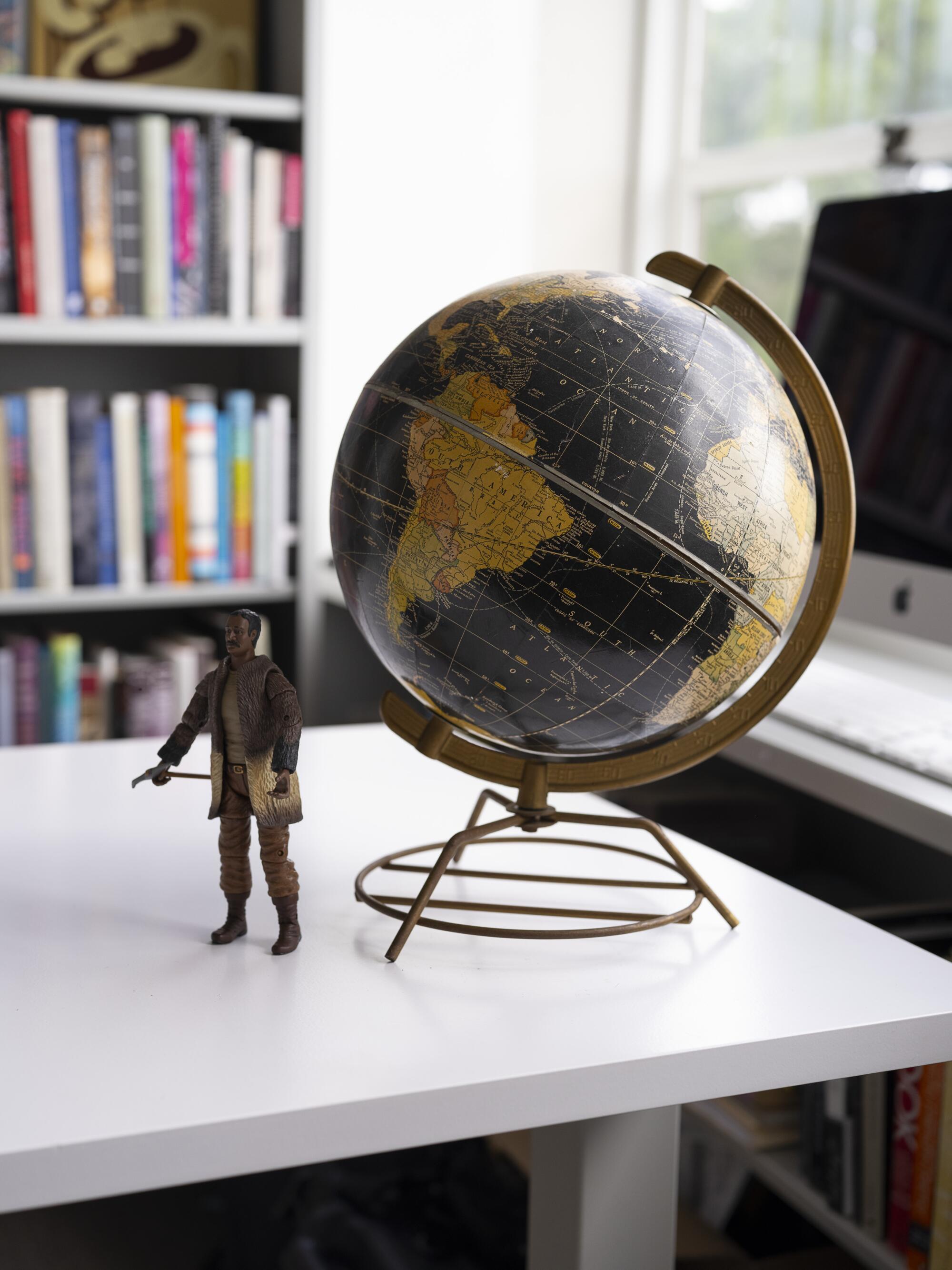
We were taught how to help people die from early on. Now, watching how people die, and how we allow them to die, I feel like an alien a lot. I’m like, why are we still moving? Why didn’t the planet stop spinning? Why didn’t everybody just stop? The thing that is most remarkable is there are certain bodies whose mortality is afforded that attention — Queen Elizabeth, for example. For me, for example, my grandmother, the seamstress, deserves to be laid in state for several days and to have people come and say goodbye to her just like anybody else.
AF: Anderson Cooper has a podcast about grief. My friend sent me this episode and one thing Elizabeth Alexander said on there is that Black Americans use the phrase “somebody passed,” and I really never had thought about it that way. But I’m thinking about how many times I have felt like it was an abrupt thing to say that somebody died, and why that feels like you’re being handled roughly when somebody says that.
RCL: When my dad died — he was my favorite person on the planet — it destroyed me. And I’m proud of that, that’s appropriate. But I remember I couldn’t bear to hear people who didn’t know him say his name. I would grow enraged — get his name out your mouth. You never met him. You don’t know what it means to have been born in 1923, to be a math genius and have to be a janitor for decades in order to raise your children, because your parents could only afford to send one child to college and not both. We can’t even fathom the histories — that’s what this book is about. The histories are in these bodies, and not just the immediate histories; I’m really interested in the kind of rugged, hearty, extraordinary, indestructible power of the cell. What our cells have seen and done, and what you’ve passed on to your daughter, what I passed on to my daughter. What we don’t even know. All of that biological intelligence, innate intelligence in our bodies. That’s why I’m interested in deep time. It’s like we don’t even know what our bodies know. We don’t know what our bodies can do.
Angela Flournoy is the author of the novel “The Turner House” and a third-generation Angeleno.
More stories from Image
